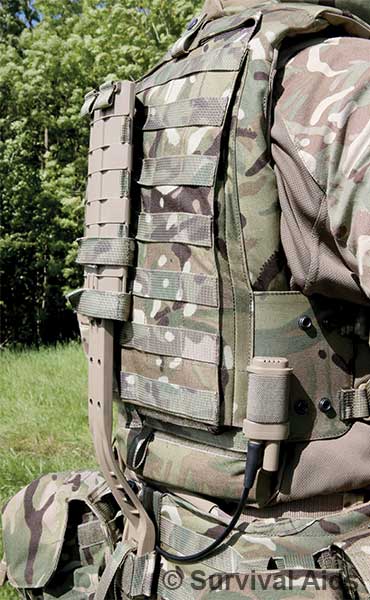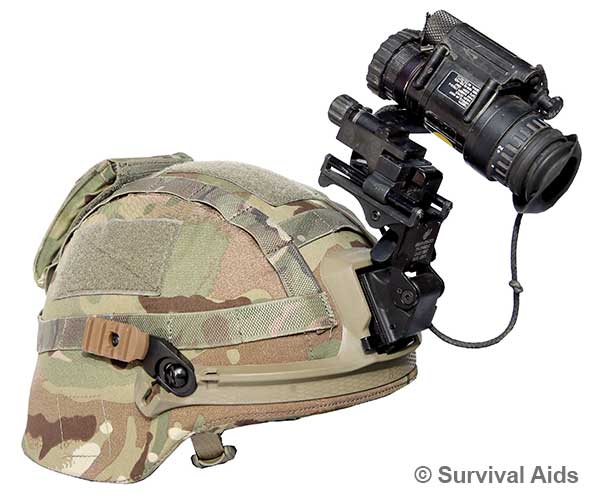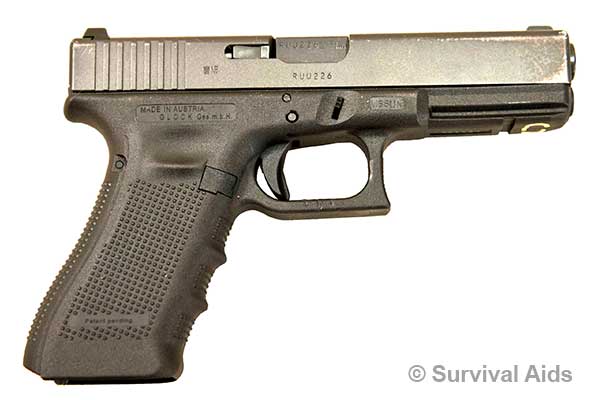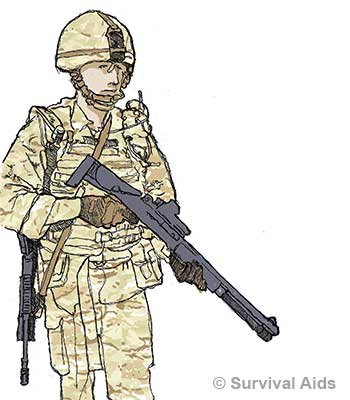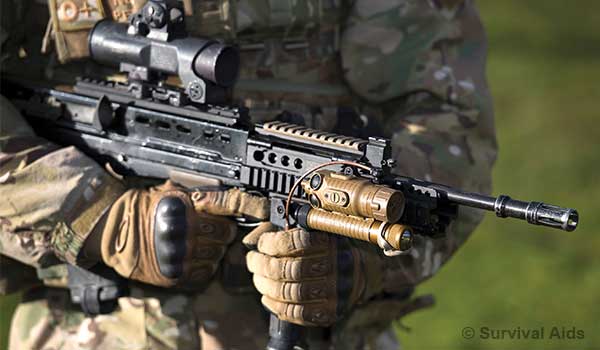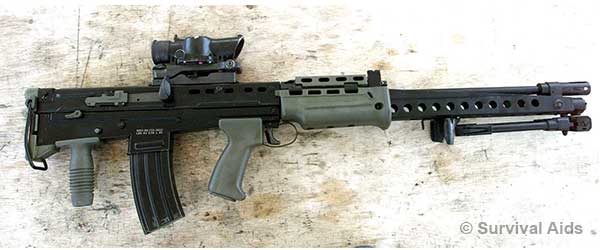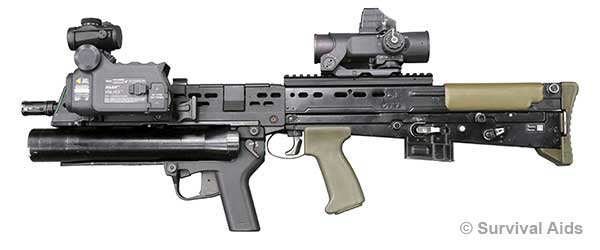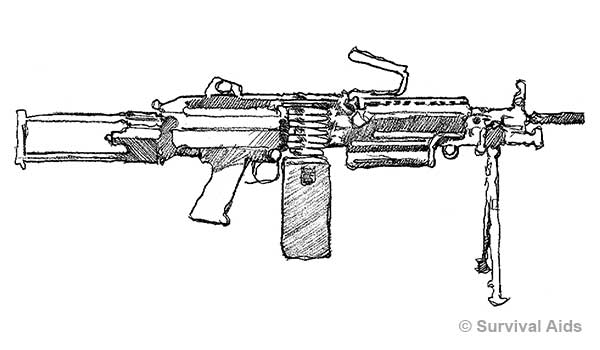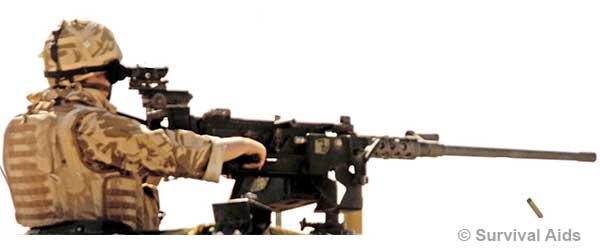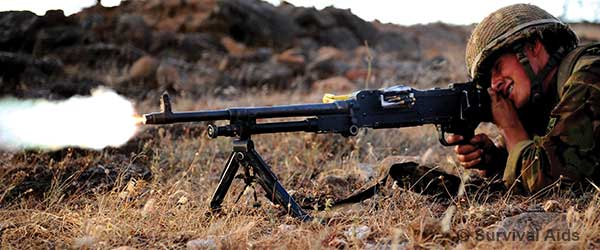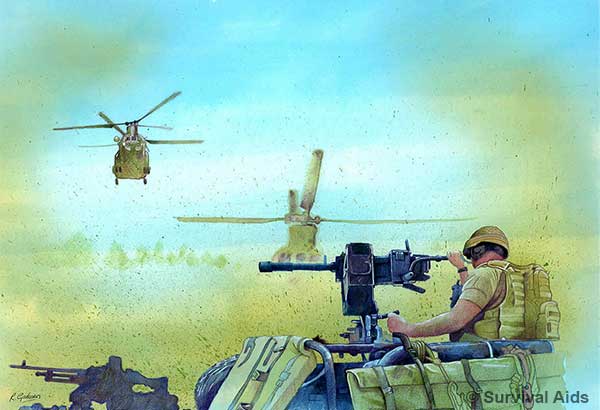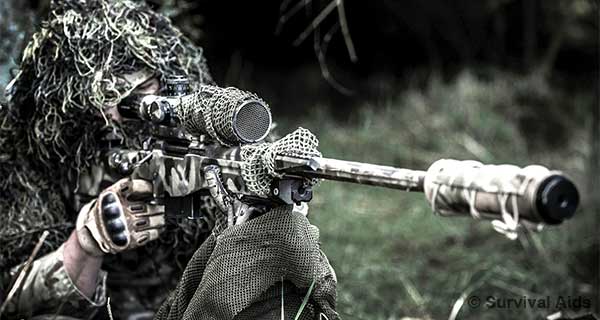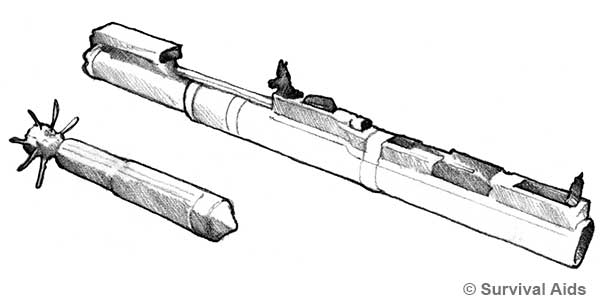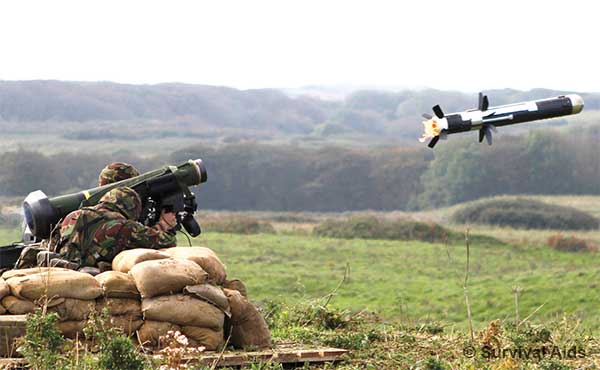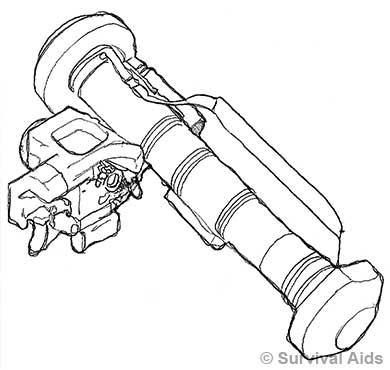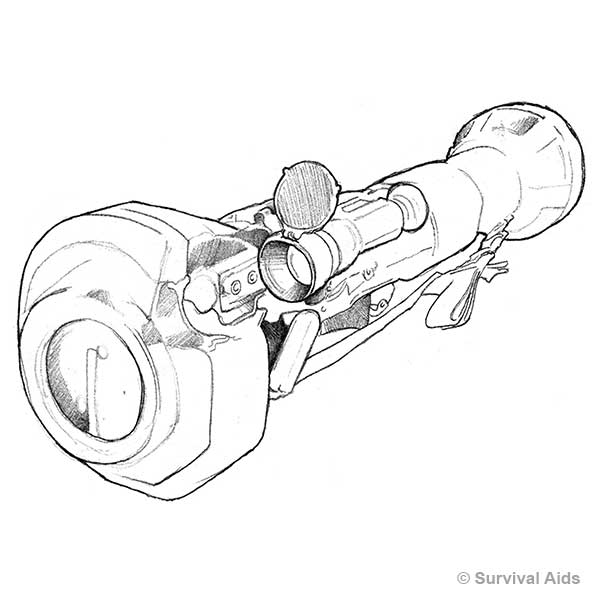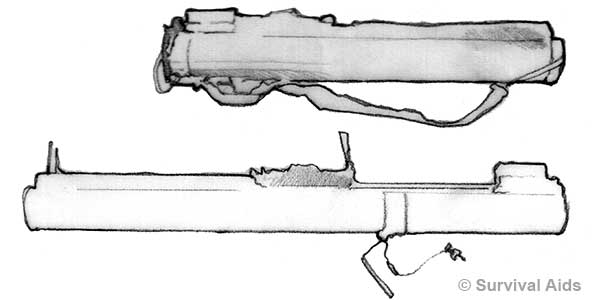THE WEAPONS THAT THE BRITISH ARMY USES
VIRTUS
Virtus is the Roman god of honour and military prowess, therefore it’s no surprise that it is also the name for the new British Military body armour system that is being rolled out to many front line units. It has replaced the much heavier Osprey that has seen so much action over the last 10 years.
With a new uncertain era unfolding for the British Tommy, new challenges, new international partners, and potential threats they needed an uplift in the kit to reflect their flexibility. The large scale wars in Afghanistan and Iraq (for us at least) are behind us now, all three services are re-examining their roles, many lessons have been hard-learned in the sands and the need for a more adaptable, modular, comfortable system of protection and carriage was long overdue.
The Taliban used to refer to British Soldiers as tortoises, due to the absurd weight of the kit they used to carry around. When the boys and girls came under fire they’d hit the ground and it’d be bloody hard to get back up again. Harder still against an enemy that could hide in plain sight and were armed with flip flops, AK47s and walkie talkies.
Speaking from experience, wearing Osprey and a full combat load of belt kit and daysack having walked across a wooden bridge in Helmand hearing bits of the bridge falling into the torrent below, it was a hair raising few minutes. Soldiers would shoulder 22KG of kit, many were knackered before the enemy had even fired a shot.
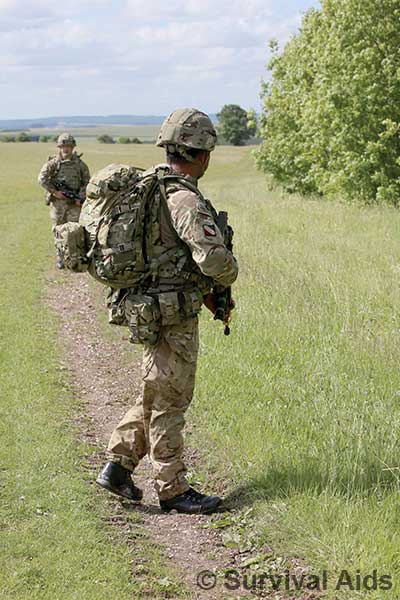
British Army body armour
VIRTUS BODY ARMOUR
At the core of the Virtus system is the STV or Scalable Tactical Vest. When a soldier is fitted for it initially a measurement of torso length as well as the chest size is taken (instead of just height) there are 7 different sizes of STV. Wearers can use both ECBA plates and Osprey plates in Virtus which is a useful design detail. Virtus can be fitted for numerous different roles. If no ballistic protection is needed the STV vest (which takes normal MOLLE fitted pouches) can be used as a simple load-carrying platform (before any hard or soft plates are added). Adding to this it is then fitted with a soft padded inner, made up of a composite granular material which turns it into a fragmentation vest. Soldiers can then add to this frag vest a series of the different front, back and side armour plates to make it a full-body armour system to suit the task at hand.
Full body armour system
The padded inner and plate carrier has a much lower profile and weight than Osprey so soldiers are freer to move and lighter on their feet. Another feature of Virtus is an integral spine called a dynamic weight distribution system. This is attached to the battle belt and can be attached and detached when needed. It serves to spread the weight of the soldiers load more evenly over the hips and shoulders.
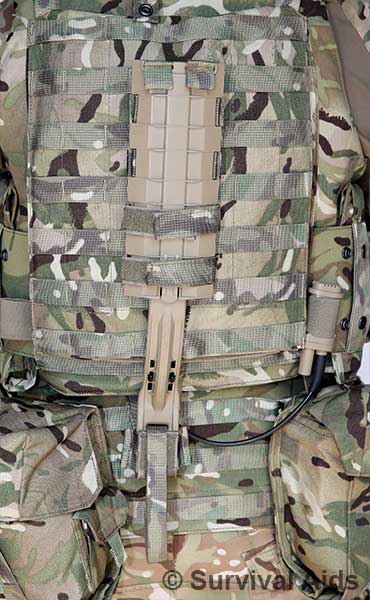
A dynamic weight distribution system
VIRTUS HELMET
The helmet is a full 350g lighter than the Mk 7 that it replaces, it has been designed in such a way that it’s easier to fire from the prone position, which has always been an infuriating feature of helmet design before. It has enhanced protection at the sides, comes fitted with a permanent fitting for night sights on the front and when wearing NVGs even has a counterweight on the back to balance the load.
Virtus Helmet
Front protection for the face comes in the form of a mandible and a visor with several different lenses for bright sunlight and night driving. The mandible makes the helmet looks quite futuristic, but it’s a sensible addition bearing in mind the new range of combat vehicles HM Forces now owns post-Afghanistan. The next generation of soldiers is going to spend more time behind the wheel than their forebears.
Virtus is a very well thought out system, ergonomically designed around the soldier to fit him/her and to provide optimum movement and protection. Time will tell if it is popular, the army is resistant to change and I know from initial inspection the Bergen to me look over fiddly with lots of zips, straps and pouches when all I really want is a big bag on my back that I can fill with bombs, bullets and brew kit.
GLOCK 17
The Glock 17 has just entered service, 25,000 have been purchased and soldiers were being trained upon it before deploying to Afghanistan in Oct 2013. It replaces the trusty Browning Hi Power 9mm which has been in service for 40 yrs.
Glock 17
Austrian engineer Gustav Glock built his pistol using a high-strength nylon-based polymer called Polymer 2, it is sometimes referred to as the “plastic pistol”, there were concerns initially that it would evade metal detection as well as not being robust enough. Glock 17’s frame, magazine body and several other components are made from Polymer 2.
The pistol’s 9mm rounds feed from staggered-column or double stack magazine, that have a 17-round capacity (hence the name) it can be fired left or right handed.
Range: 50 metres
Calibre: 9 mm
Weight: 32 oz / 907 grams
Mag Capacity: 17 rounds magazine
Safety: The Browning 9mm had a conventional safety catch, the Sig 226 (used by UK SF) had a cock de-cock mechanism and the Glock has its own peculiar safety.
Gustav Glock designed the “safe action” system which consists of a thin bar resembling another trigger within the weapons actual trigger. Unless the firers finger is firmly placed/committed to taking the shot it’s unlikely to function.
THE L129A1 SHARPSHOOTER / SNIPER RIFLE
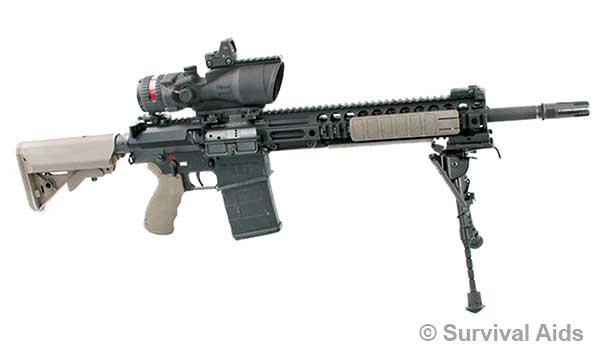
L129A1 Sharpshooter / Sniper rifle
The L129A1 Sharpshooter / Sniper rifle was born from the urgent requirements that came from the British Forces deployed to Afghanistan. The Taliban had a tactic of engaging convoys and foot patrols from stand-off ranges of 500 meters or more using 7.62mm rifles and machine guns.
5.56mm weapons such as the SA80, LSW and Minimi LMG were found to be ineffective at these ranges and a UOR was issued for a semi-automatic rifle, chambered for 7.62 x 51 NATO ammunition, which is capable of engaging individual targets out to 800 meters. These rifles are intended for use at section and platoon levels.
Calibre: 7.62mm NATO
Operation: Gas operated semi- automatic
Weight: 4.5 kg Length: 900-990 mm
Barrel length: 406 mm / 16”
Feed: 20 Rounds detachable box magazine
The Sharpshooter / Sniper rifle is a gas-operated, semiautomatic weapon, fitted with ambidextrous controls (safety and magazine release) at the end of the barrel is a surefire flash suppressor. Fitted with a 20 round magazine and a Trijicon ACOG 6 x 48 telescopic site, as well as additional folding back-up iron sights. All sighting equipment and accessories, such as a folding bipod, quick-detachable sound moderator (silencer) or a 40mm M203 UGL are attached using the Picatinny rail system.
M4 SUPER 90 COMBAT SHOTGUN
Semi-automatic, fires a 12 bore shot/shell cartridge and is fitted with a detachable Eotech Sight (for use by day or night) which sits on a standard Picatinny rail. It has an iron sight and a telescopic 3-position extendable buttstock.

M4 SUPER 90 COMBAT SHOTGUN
The shotgun can be fitted with a single point elasticated sling or the issue rifle sling and can be fired from any of the conventional fire positions.
The section point man or lead scout assumes the first and most exposed position, often being the first to engage the enemy. The shotgun enables him to apply a quick rapid rate of fire over a large area. Commanders must remember to rotate the LS due to the tiring nature of the role.
Cam and Concealment
Range:
Solid shot: 130m
Buckshot: 40m
Length: 1010mm (extended buttstock) 886mm (closed buttstock)
Weight: 3.8kg
Magazine: 7 cartridges
Calibre: 12 gauge (18.4mm)
SA80 MK2, THE RIFLE OR IW (INDIVIDUAL WPN)
SA80 A2 comprises the Individual Weapon (IW) and the Light Support Weapon (LSW) the army’s standard combat weapons. It has been modified in light of operational experience, a Picatinny rail has been added around the barrel, enabling the attachment of torches, grips and sights.
SA80 A2 Rifle
Calibre: 5.56 mm
Weight: 4.98 kg (loaded mag, optical sight)
Length: 785 mm
Barrel length: 518 mm
Feed: 30-round magazine
Effective range: 400 m
Sights SA80 can be fitted with a range of sight systems (1) SUSAT sight (2) Iron Sights (3) Common Weapon Sight (CWS) also known as the Kite Sight which amplifies ambient light (4) ACOG x 4 magnification sight with an Eotech sight above the optic.
ISW weapon military gun
The adoption of 5.56mm ammunition after lessons learned during the Falklands conflict, enabled soldiers to carry more rounds than 7.62mm of the old SLR, it has a smaller recoil than 7.62, and thanks to this is more accurate but it does lack the “man dropping punch” of 7.62. It was felt that the section lacked a firepower element hence the introduction of the Minimi LMG.
SA80-A2 WITH UGL
The SA80 Underslung Grenade Launcher (UGL) is an H&K 40mm grenade launcher. Infantry sections get one per fire team, enabling accurate firing of 40 mm grenades, both HE and frag out to 400 metres.
SA80-A2 with Underslung Grenade Launcher (UGL).
Also fitted with the Wilcox Rapid Acquisition Aiming Module (RAAM UGL-FCS). A motorized gimbal housing visible and infrared laser pointers automatically articulate to indicate the proper weapon elevation necessary to match the trajectory of 40mm grenade in flight to hit its intended target.
MINIMI LIGHT MACHINE GUN (LMG) 5.56 MM
is a 5.56 mm, gas-operated, air-cooled weapon, capable of fully automatic fire only, it can be both belt and magazine-fed with STANAG link and magazines.
Military Gun MINIMI MG
Should the gunner run out of linked ammunition, magazines can be used, however, malfunctions can occur because the magazine spring has difficulty feeding rounds quickly enough to match the Minimi’s high cyclic rate.
A folding bipod is attached near the front of the gun, and it has a quick-change barrel, it’s relatively lightweight (7kg to the GPMG’s 14 calibre kg) provides the section with the heavy volume of fire of a machine gun, combined with accuracy and portability approaching that of a rifle.
HEAVY MACHINE GUN (HMG)
Heavy Machinery Gun
The powerful L1A1 12.7 mm (.50) Heavy Machine Gun (HMG) is an updated version of the Browning M2 ‘Fifty-cal’ - recognised as one of the finest heavy machine guns ever developed.
The HMG provides integral close-range support from a ground mount tripod or fitted to a Land Rover using the Weapon Mount Installation Kit (WMIK) and a variety of sighting systems.
The performance of the HMG has recently been enhanced with a new ‘soft mount’ (to limit recoil and improve accuracy) and a quick change barrel (QCB).
Calibre: 12.7 mm
Weight: 38.15 kg (gun only)
Length: 1,656 mm
Feed: 50-round disintegrating belt
Effective range: 2,000 m
Rate of fire: 485 - 635 rounds/min
The HMG provides the commander with added capability at greater ranges (1500-2000m) when support from armoured vehicles is not available.
The HMG should never be fired while the vehicle is moving because accuracy can be affected due to the movement of the vehicle.
THE L7A2 GENERAL PURPOSE MACHINE GUN (GPMG)
The GPMG aka: “the general, the gun or the jimpy” is a 7.62 mm belt-fed general-purpose machine gun.
General Purpose Machine Gun
Calibre: 7.62 mm
Weight: 13.85 kg (gun plus 50-round belt)
Length: 1,230 mm (light role)
Feed: 100-round disintegrating link belt
Effective range: 800 m light role, 1,800 m sustained fire role
Rate of fire: 750 rounds per minute
In the SF role, mounted on a tripod and fitted with the C2 optical sight, it is fired by a two-man team who are grouped in a specialist machine gun platoon to provide battalion-level fire support. In SF mode, the GPMG, with a two-man crew, lays down 750 rounds-per-minute at ranges up to 1,800 meters.
The GPMG can be carried by foot soldiers and employed as a light machine gun (LMG), although it has largely been replaced by the lighter 5.56 x 45mm Minimi in this role in most regiments.
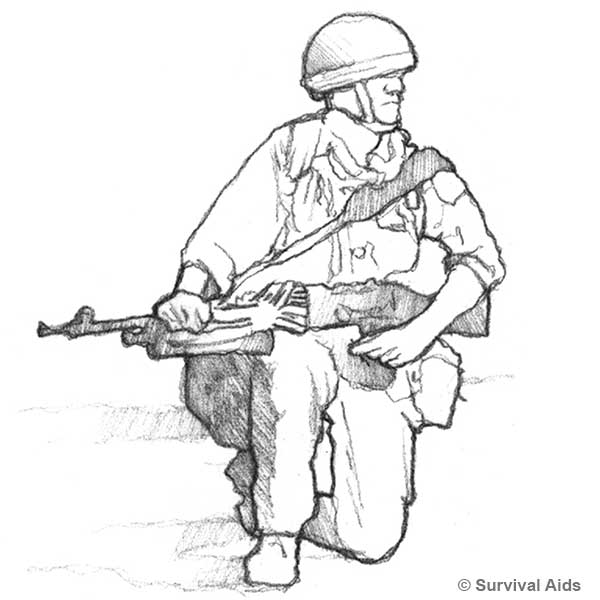
The Gimpy Gunner
A fold-out bipod is used to support the GPMG in the LMG role. Versions of the GPMG are mounted on most army vehicles and some helicopters.
GRENADE MACHINE GUN (GMG)
The Heckler & Koch 40mm Grenade Machine Gun (GMG) provides unrivalled infantry suppression, combining the best characteristics of the heavy machine guns or light mortars, usually employed in this role.
Medivac chopper
Conventional rifle ammunition provides no fragmentation effect and is largely not effective enough against advancing armoured infantry fighting vehicles and battle tanks. On the other hand, mortars have the disadvantage of a relatively low rate of fire.
Rate of fire: 340 rounds per minute
Range: 1.5 km for point targets, 2km for area cover
Ammunition: 40 mm high velocity and high explosive grenades
The GMG combines the advantages of both of these two types of weapons delivering high flexibility and firepower combined with the fragmentation effect of mortar ammunition.
The GMG is normally mounted on WMIK (weapons mount installation kit) or the other vehicles in the TSV family, but it can also be dismounted and used from a ground-based tripod.
L115A3 LONG RANGE RIFLE
The L115A3 rifle is part of the sniper's system improvement programme (SSIP). It fires an 8.59mm round, which is heavier than the 7.62 round of the L96 and less likely to affected by wind over long ranges. It is equipped with telescopic day and night all-weather sights, capable of first-round hits at 600 metres and harassing fire up to 1,000 metres. The L96, however, is by no means obsolete and will often be found carried by the number two in order to engage closer more opportunistic targets.
L115A3 Long Range Rifle
Other improvements in the SSIP included:
a. The day scope magnifies targets up to 25 times allowing the sniper to identify targets more easily.
b. Folding stock reduces the length of the weapon, so it can be carried in a bergen or daysack.
c. Adjustable cheek piece for more comfortable alignment.
d. Suppressor reduces flash and noise, increasing survivability.
e. Adjustable Bi-pod supports the rifle in a set position for easier target location.
f. 5-round magazine allows the sniper to fire 5 rounds rapidly while being small enough not to interfere with the alignment.

Improvements on SSIP
L16A2 81MM MORTAR
Is a battle group level indirect fire weapon which is capable of providing accurate high explosive, smoke and illuminating rounds out to a maximum range of 5,650m.
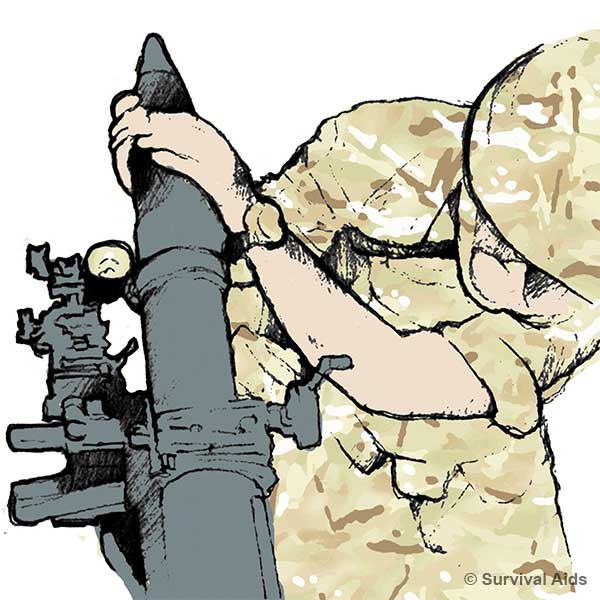
L16A2 81mm Mortar
The mortar platoon in mech. and Armd Inf Bns are mounted in and fire from APCs, increasing its mobility and enabling rapid disengagement and movement.
It can be man-packed, in three loads each approx 11 kg (barrel, base plate and bipod with sights) ammunition carried by the rest of the Bn - each man carrying two greenies (double plastic containers, total four bombs) in addition to his normal equipment, but this is pretty unpleasant for all involved (especially the carrier of the bipod) and is generally avoided.
Weight: 35.3 kg
Barrel length: 1,270 mm
Crew of : 3
Shell weight: 4.3 kgs
Caliber: 81 mm
Rate of fire: 1-12 rpm sustained, 20 rpm
in exceptional circumstances and for short periods.
Effective range: HE: 100-5,675 m Illumination: 400-4,800 m smoke: 100-5,675
Maximum range: 5,650m (HE) Sights Optical: (C2) with Trilux illumination
The infantry transports it normally by a vehicle or helicopter and assembled for firing from the ground.
THE LIGHT ANTISTRUCTURES MISSILE
LASM is a single-shot, unguided rocket, housed in a telescopic launcher, a one-shot system discarded after launch. LASM is smaller and lighter to carry than the 84mm ILAW.
Similar in appearance to the LAW 66, the main difference is the LASM’s larger warhead, 1kg of enhanced explosives compared to a third of a kilo found in the 66.
Anti Structured Missile
LASM uses it’s kinetic energy to penetrate the outer walls of a structure before the high explosive warhead detonates inside, in plain English a “break in charge followed by a follow up bomb”
“kinetic energy of an object is the energy which it possesses due to its motion”
The sight system, rear/foresight “pops up” when the launcher is extended, in preparation for firing. Spring-loaded fins deploy on firing to stabilise the rocket in flight.
The LASM is very similar to the M72 LAW 66mm rocket launcher. While the LASM is effective against light armour and soft-skinned vehicles, its primary use in Afghanistan is against fixed positions, bunkers and other buildings.
Range: 250 m
Weight: 4.3 kg
Length: 0.775 m
Firing length: 0.98 m
Prep time: 8 seconds
JAVELIN
Javelin is a man-portable medium range, anti-tank guided weapon, replacing Milan. It has a tripod (for firing and observation) and has longer range, greater lethality, more powerful all-weather, day/night optics and a lighter load for the infanteer than Milan.
Javalin Military Weapon
Designed initially to destroy tanks and AFV, javelin is also employed against fixed defences, bunkers and buildings. The system allows the firer to lock-on the target, fire and ‘forget’. So as soon as the missile is launched, the firer can move on, switch targets or move position. javelin has a maximum range of 2500 m.
Javelin adopts a top-attack flight profile against AFV (attacking the top armour which is thinner) and a direct-attack mode for use against buildings or fortifications.
Javelin Clu Weapon
The missile itself is a tandem warhead, fitted with two shaped charges, an initial charge to get through explosive reactive armour if it’s fitted and the main warhead to penetrate the armour.
NLAW (NEXT GENERATION ANTI-TANK WEAPON)
NLAW is a man-portable, disposable, anti-tank weapon, a soft-launch system, allowing it to be fired from a window within a confined space without any backblast.
Next-Generation Anti Tank Weapon
The rocket is propelled out of launcher using a low power charge, it travels several meters before its main ignition kicks in which propels the missile to the target.
Portable, night vision capable, short-range and fire-and-forget, NLAW was due to replace the British Army’s LAW 80 system, as well as the ILAW (Interim Lightweight Anti-tank Weapon).
Calibre: 115/150 mm
Weight: 12.5 kg
Muzzle velocity: Initial: 40 m/s
Maximum: Subsonic
Range: Minimum: 20 m Maximum: 600 m
Attack Modes: OTA (Overflying Top Attack) and DA (Direct Attack)
Temperature range: -38 to +63 ºC
The NLAW consists of a single missile sealed within a launching tube, main battle tanks, armoured fighting vehicles, troops in buildings and non-armoured vehicles can all be defeated by NLAW. It has an optional drop-down lightweight support arm to assist in aiming and can be bought into the aim and fired in under 5 seconds.
NLAW is designed to be carried and fired by a single non-expert soldier, it is easy to handle and relatively soldier proof.
THE M72 LAW AKA THE 66
LAW 66 is a lightweight, one-shot, disposable rocket launcher, that is highly effective against soft-skinned vehicles and light armour, up to a range of 200 meters. 66s can also be used against bunkers or buildings, it is ineffective against MBTs, although in skilled hands one could be used to disable the tracks.
The 66 lightweight rocket
The weapon consists of a rocket inside two tubes, one inside the other, the launcher extends to just under 1 meter when ready to fire.
The outer tube contains the trigger, the arming handle, front and rear sights and acts as a water-resistant container for the rocket. The inner tube houses the firing pin assembly, including the detent lever.
When fired, the rocket propels the 66 mm warhead forward without much recoil. As the warhead emerges from the launcher, six fins spring out from the base, stabilizing its flight. LAW uses a piezoelectric fuse system, on impact crystals in the nose are crushed causing a micro-second electric current which detonates the warhead.
Upon impact, the main charge functions and forces the copper liner into a molten slug, that in relation to the size of the warhead is capable of the massive amount of penetration. Basically a flying EFP.
Weighing just 2.5kg and with a carrying length of 0.67 meters, the LAW is designed to be carried slung over the shoulder.





